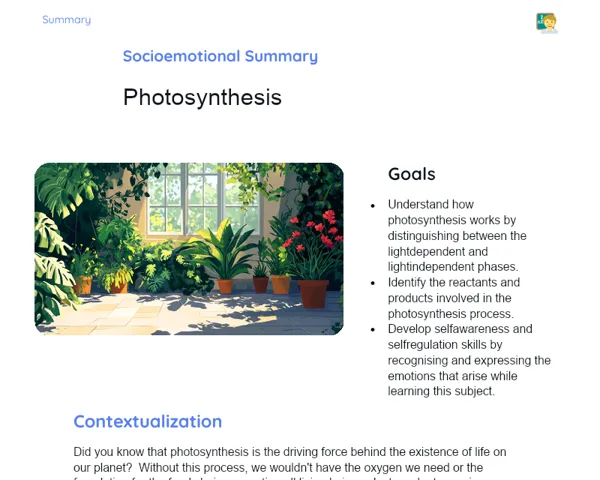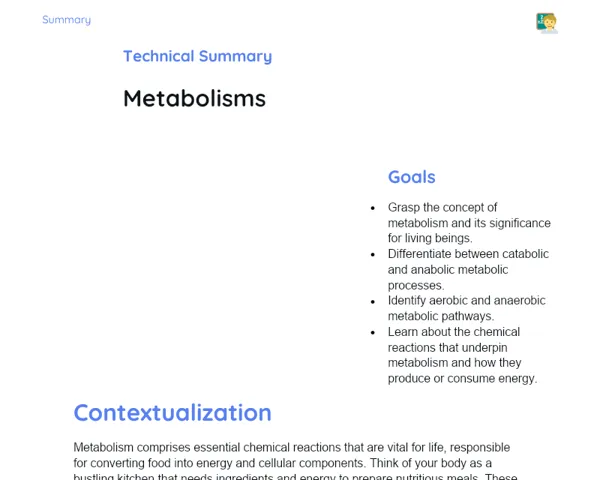Objectives
1. Identify the key organs that comprise the nervous system, such as the brain and the medulla oblongata, and explain their specific roles.
2. Gain an understanding of the central and peripheral nervous systems, distinguishing between their functions and how they work together to process information and coordinate actions within the body.
Contextualization
Did you know that the nervous system can process information at lightning speed? For instance, the human brain is capable of performing around 10 quadrillion operations every second, far surpassing any known supercomputer! This remarkable ability not only enables us to think but also helps regulate essential functions like breathing, muscle movement, and our reactions to external stimuli, all within moments. Grasping the intricacies of this complex system is crucial, as it enhances our understanding of biology and our interactions with the world around us.
Important Topics
Brain
The brain serves as the command center of the nervous system, overseeing a multitude of functions ranging from processing sensory information to managing both voluntary and involuntary actions. It is made up of several specialized parts, including the cerebral cortex, which plays a key role in memory, attention, perception, cognition, and consciousness.
-
The cerebral cortex is divided into four lobes, each responsible for unique functions: the frontal lobe for controlling movement and the temporal lobe for memory.
-
The brain is encased in the skull and is supported by cerebrospinal fluid, which helps maintain consistent pressure within the skull.
-
Injuries or damage to the brain can significantly impact cognitive and motor functions, underscoring the essential role of this organ in human performance.
Medulla Oblongata
The medulla oblongata is a crucial part of the brainstem situated at the brain's base, linking the brain to the spinal cord. It manages automatic body functions such as heartbeat, breathing, blood pressure, and digestion. The medulla is also vital for regulating sleep patterns and reflex actions.
-
The medulla is indispensable for survival as it manages vital functions beyond conscious control, like breathing.
-
Injury to the medulla can result in severe health complications, such as respiratory failure, highlighting its critical importance for sustaining life.
-
Examining the medulla and its functionalities aids in understanding medical conditions impacting these automatic functions, such as sleep apnea and specific forms of epilepsy.
Peripheral Nervous System
The peripheral nervous system encompasses all the nerves beyond the central nervous system. It includes afferent nerves that carry sensory information to the brain and efferent nerves that transmit commands from the brain to other body parts. This system is vital for maintaining effective communication between the brain and the body, enabling prompt responses to external stimuli.
-
Peripheral nerves can sustain damage from accidents, infections, or diseases, leading to challenges like paralysis and sensory impairment.
-
Studying the peripheral nervous system is crucial for understanding neurological disorders such as diabetic polyneuropathy and multiple sclerosis that directly impact peripheral nerve function.
-
Approaches for nerve regeneration and treatment of injuries often emphasize the peripheral nervous system due to its greater regenerative abilities compared to the central nervous system.
Key Terms
-
Central Nervous System (CNS): Comprising the brain and spinal cord, responsible for processing and integrating information.
-
Peripheral Nervous System (PNS): Encompassing all nerves outside the central nervous system, responsible for transmitting messages between the CNS and other body parts.
-
Neuron: The basic functional unit of the nervous system, consisting of a cell body, dendrites, and an axon that transmits electrical and chemical signals.
For Reflection
-
How might the impairment of a component within the nervous system, like the medulla, affect human survival, and what medical and ethical dilemmas could arise?
-
In what ways does understanding the nervous system facilitate the development of assistive technologies for individuals experiencing neurological challenges?
-
Why is it crucial to understand the nervous system for the prevention and management of mental and emotional health disorders?
Important Conclusions
-
We delved into the marvels of the nervous system, from the brain's astonishing ability to process vast amounts of information to the pivotal role of the medulla in regulating critical functions such as breathing and heartbeat.
-
We successfully distinguished between the central nervous system, which is responsible for information processing and integration, and the peripheral nervous system, which links the CNS with the rest of the body for rapid responses to stimuli.
-
We learned about the structure and functions of neurons, the fundamental units of nervous system operations, and how injuries or disorders within this system can significantly affect our daily lives and overall health.
To Exercise Knowledge
- Concept Map of the Nervous System: Design a concept map that illustrates the main organs and functions of the nervous system, detailing how injuries in various areas can impact bodily operations.
- Emergency Simulation: Compose a hypothetical emergency scenario and explain how both the central and peripheral nervous systems would work to tackle the situation.
- Interview with a Neuroscientist: Prepare questions and interview a neuroscientist (this could be a professional or researcher) to gain insights into the practical applications of nervous system research and the latest advancements in the field.
Challenge
🧠 Neuro Detective Challenge: Picture yourself as a detective probing a 'crime' where someone's nervous system has been 'attacked'. Leverage your knowledge to pinpoint the 'culprit' (a specific medical condition) and draft a detailed report of your findings, encompassing symptoms, treatments, and expected outcomes.
Study Tips
-
Utilize educational videos and animations to visualize the structure and function of the nervous system, which will aid in consolidating your grasp of complex ideas.
-
Join online forums or study groups focused on biology or neuroscience to discuss inquiries and discoveries with fellow students and enthusiasts.
-
Explore augmented reality or virtual reality applications that allow you to 'navigate' the nervous system interactively, making your learning experience more engaging and memorable.



